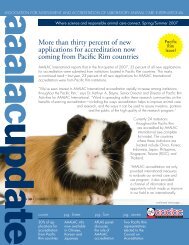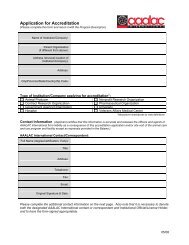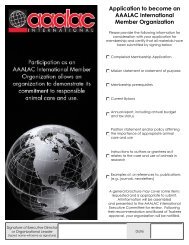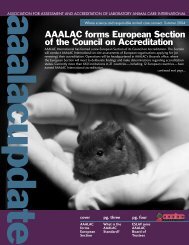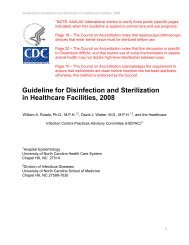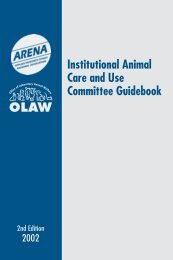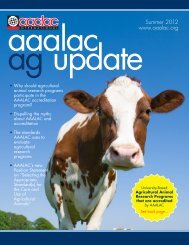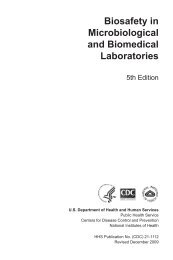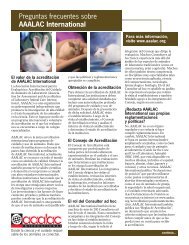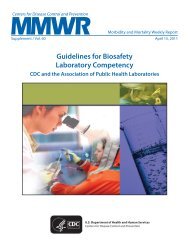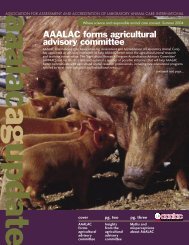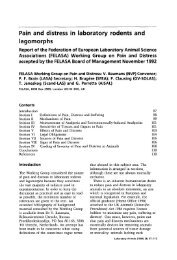20 CHAPTER 3gases, particulates, <strong>and</strong> liquid aerosols, <strong>in</strong>clud<strong>in</strong>g thosecarry<strong>in</strong>g microbes <strong>of</strong> various sorts.Good ventilation, waste management, <strong>and</strong> husb<strong>and</strong>ryusually result <strong>in</strong> acceptable air quality. Ammonia,hydrogen sulfide, carbon monoxide, <strong>and</strong> methane are<strong>the</strong> pollutant gases <strong>of</strong> most concern <strong>in</strong> animal facilities(Curtis, 1986). In addition, OSHA (1995) has establishedallowable exposure levels <strong>for</strong> human workers with8 h <strong>of</strong> exposure daily to <strong>the</strong>se gases. The concentration<strong>of</strong> ammonia to which animals are exposed ideally shouldbe less than 10 ppm <strong>and</strong> should not exceed 25 ppm, buta temporary excess should not adversely affect animalhealth (Von Borell et al., 2007). Comparable concentrations<strong>for</strong> hydrogen sulfide are 10 <strong>and</strong> 50 ppm, respectively.The concentration <strong>of</strong> carbon monoxide (aris<strong>in</strong>gfrom unvented heaters) <strong>in</strong> <strong>the</strong> air brea<strong>the</strong>d by animalsshould not exceed 150 ppm, <strong>and</strong> methane (which isexplosive at certa<strong>in</strong> concentrations <strong>in</strong> air) should notexceed 50,000 ppm. Special ventilation is required whenunderfloor waste pits are emptied because <strong>of</strong> <strong>the</strong> potentiallylethal hazards to animals <strong>and</strong> humans from <strong>the</strong>hydrogen sulfide <strong>and</strong> methane gases that are released.Many factors affect airborne dust concentration, <strong>in</strong>clud<strong>in</strong>grelative humidity, animal activity, air velocity,<strong>and</strong> type <strong>of</strong> feed. Dust concentration is lower at higherrelative humidities. High animal activity <strong>and</strong> air velocitiesstir up more particles <strong>and</strong> keep <strong>the</strong>m suspendedlonger. Fat or oil added to feed reduces dust generation(Chiba et al., 1985). Microbes <strong>and</strong> pollutant gases mayattach to airborne dust particles.The allowable dust levels specified by OSHA (1995)are based on exposure <strong>of</strong> human workers <strong>for</strong> 8 h dailywithout facemasks; allowable dust levels are 5 mg/m3<strong>for</strong> respirable dust (particle size <strong>of</strong> 5 μm or less) <strong>and</strong> 15mg/m3 <strong>for</strong> total dust. Although animals can toleratehigher levels <strong>of</strong> <strong>in</strong>ert dust with no discernible detrimentto <strong>the</strong>ir health or well-be<strong>in</strong>g (Curtis <strong>and</strong> Drummond,1982), <strong>the</strong> concentration <strong>of</strong> dust <strong>in</strong> animal house airshould be m<strong>in</strong>imized.Concentrations <strong>of</strong> microbes <strong>in</strong> <strong>the</strong> air should be m<strong>in</strong>imized.Dust <strong>and</strong> vapor pressure should be controlled.The ventilation system should preclude <strong>the</strong> mix<strong>in</strong>g <strong>of</strong>air from <strong>in</strong>fected microenvironments with that from microenvironments<strong>of</strong> un<strong>in</strong>fected animals.Light<strong>in</strong>gLight<strong>in</strong>g should be diffused evenly throughout an animalfacility. Illum<strong>in</strong>ation should be sufficient to aid <strong>in</strong>ma<strong>in</strong>ta<strong>in</strong><strong>in</strong>g good husb<strong>and</strong>ry practices <strong>and</strong> to allow adequate<strong>in</strong>spection <strong>of</strong> animals, ma<strong>in</strong>tenance <strong>of</strong> <strong>the</strong> wellbe<strong>in</strong>g<strong>of</strong> <strong>the</strong> animals, <strong>and</strong> safe work<strong>in</strong>g conditions <strong>for</strong>personnel. <strong>Guide</strong>l<strong>in</strong>es are available <strong>for</strong> light<strong>in</strong>g systems<strong>in</strong> animal facilities (MWPS, 1987b).Although successful light management schemes areused rout<strong>in</strong>ely <strong>in</strong> various animal <strong>in</strong>dustries to supportreproductive <strong>and</strong> productive per<strong>for</strong>mance, precise light<strong>in</strong>grequirements <strong>for</strong> <strong>the</strong> ma<strong>in</strong>tenance <strong>of</strong> good health<strong>and</strong> physiological stability are not known <strong>for</strong> most animals.However, animals should be provided with bothlight <strong>and</strong> dark periods dur<strong>in</strong>g a 24-h cycle unless <strong>the</strong>protocol requires o<strong>the</strong>rwise. See Chapters 6 through 11<strong>for</strong> references on light<strong>in</strong>g <strong>and</strong> photoperiod <strong>in</strong> <strong>in</strong>dividualspecies. Red or dim light may be used if necessary tocontrol vices such as fea<strong>the</strong>r-peck<strong>in</strong>g <strong>in</strong> poultry <strong>and</strong>tail-bit<strong>in</strong>g <strong>in</strong> livestock.Provision <strong>of</strong> variable-<strong>in</strong>tensity controls <strong>and</strong> regularma<strong>in</strong>tenance <strong>of</strong> light fixtures helps to ensure light <strong>in</strong>tensitiesthat are consistent with energy conservation<strong>and</strong> <strong>the</strong> needs <strong>of</strong> animals (as <strong>the</strong>y are understood), aswell as provid<strong>in</strong>g adequate illum<strong>in</strong>ation <strong>for</strong> personnelwork<strong>in</strong>g <strong>in</strong> animal rooms. A time-controlled light<strong>in</strong>gsystem may be desirable or necessary to provide a diurnallight<strong>in</strong>g cycle. Timers should be checked periodicallyto ensure <strong>the</strong>ir proper operation.Excreta Management <strong>and</strong> SanitationA complete excreta management system is necessary<strong>for</strong> any <strong>in</strong>tensive animal facility. The goals <strong>of</strong> this systemare as follows:• To ma<strong>in</strong>ta<strong>in</strong> acceptable levels <strong>of</strong> worker health<strong>and</strong> animal health <strong>and</strong> production through cleanfacilities;• To prevent pollution <strong>of</strong> water, soil, <strong>and</strong> air;• To m<strong>in</strong>imize generation <strong>of</strong> odors <strong>and</strong> dust;• To m<strong>in</strong>imize verm<strong>in</strong> <strong>and</strong> parasites;• To meet sanitary <strong>in</strong>spection requirements; <strong>and</strong>• To comply with local, state, <strong>and</strong> federal laws, regulations,<strong>and</strong> policies.The plann<strong>in</strong>g <strong>and</strong> design <strong>of</strong> livestock excreta managementfacilities <strong>and</strong> equipment are discussed by MWPS(1993).A plan should be followed to ensure that <strong>the</strong> animalsare kept reasonably dry <strong>and</strong> clean <strong>and</strong> are providedwith com<strong>for</strong>table, healthful surround<strong>in</strong>gs. Goodsanitation is essential <strong>in</strong> <strong>in</strong>tensive animal facilities, <strong>and</strong>pr<strong>in</strong>ciples <strong>of</strong> good sanitation should be understood byanimal care personnel <strong>and</strong> pr<strong>of</strong>essional staff. Differentlevels <strong>of</strong> sanitation may be appropriate under differentcircumstances, depend<strong>in</strong>g on whe<strong>the</strong>r manure packs,pits, outdoor mounds, dirt floors, or o<strong>the</strong>r types <strong>of</strong> excretamanagement <strong>and</strong> hous<strong>in</strong>g systems are be<strong>in</strong>g used.In some <strong>in</strong>stances, animals may be <strong>in</strong>tentionally exposedto excreta to enhance immunity. A written planshould be developed <strong>and</strong> implemented <strong>for</strong> <strong>the</strong> sanitation<strong>of</strong> each facility hous<strong>in</strong>g agricultural animals. Build<strong>in</strong>g<strong>in</strong>teriors, corridors, storage spaces, anterooms, <strong>and</strong>o<strong>the</strong>r areas should be cleaned regularly <strong>and</strong> dis<strong>in</strong>fectedappropriately.Waste conta<strong>in</strong>ers should be emptied frequently, <strong>and</strong>implements should be cleaned frequently. It is goodpractice to use disposable l<strong>in</strong>ers <strong>and</strong> to wash conta<strong>in</strong>ersregularly.
<strong>Animals</strong> can harbor microbes that can be pathogenicto humans <strong>and</strong> o<strong>the</strong>r species. Hence, manure should beremoved regularly unless a deep litter system or a builtupmanure pack is be<strong>in</strong>g employed, <strong>and</strong> <strong>the</strong>re should bea practical program <strong>of</strong> effective dis<strong>in</strong>fection to m<strong>in</strong>imizepathogens <strong>in</strong> <strong>the</strong> environment.For term<strong>in</strong>al clean<strong>in</strong>g, all organic debris should be removedfrom equipment <strong>and</strong> from floor, wall, <strong>and</strong> ceil<strong>in</strong>gsurfaces. If sanitation depends on heat <strong>for</strong> effectiveness,<strong>the</strong> clean<strong>in</strong>g equipment should be able to supply waterthat is at least 82°C (180°F). When chemical dis<strong>in</strong>fectionis used, <strong>the</strong> temperature <strong>of</strong> wash water may becooler. If no mach<strong>in</strong>e is available, surfaces <strong>and</strong> equipmentmay be washed by h<strong>and</strong> with appropriate detergents<strong>and</strong> dis<strong>in</strong>fectants <strong>and</strong> with vigorous scrubb<strong>in</strong>g.Health <strong>and</strong> per<strong>for</strong>mance <strong>of</strong> animals can be affectedby <strong>the</strong> time <strong>in</strong>terval between successive occupations <strong>of</strong><strong>in</strong>tensive facilities. Complete dis<strong>in</strong>fection <strong>of</strong> such quartersdur<strong>in</strong>g <strong>the</strong> unoccupied phase <strong>of</strong> an all-<strong>in</strong>, all-outregimen <strong>of</strong> facility management is effective <strong>for</strong> diseasemanagement <strong>in</strong> some situations.Programs <strong>of</strong> pasture-to-crop rotation <strong>for</strong> periodicallyrest<strong>in</strong>g <strong>the</strong> pasture <strong>and</strong> programs that permit graz<strong>in</strong>gby o<strong>the</strong>r animal species can aid <strong>in</strong> <strong>the</strong> control <strong>of</strong> soilbornediseases <strong>and</strong> parasites. Spread<strong>in</strong>g <strong>of</strong> manure onpastures as fertilizer is a sound <strong>and</strong> acceptable managementpractice but may spread toxic agents <strong>and</strong> <strong>in</strong>fectiouspathogens (Wray <strong>and</strong> Sojka, 1977). Cautionshould be exercised with manure <strong>of</strong> animals <strong>in</strong>fectedwith known pathogens, <strong>and</strong> o<strong>the</strong>r methods <strong>of</strong> waste disposalshould be considered.Animal health programs should stipulate storage,h<strong>and</strong>l<strong>in</strong>g, <strong>and</strong> use criteria <strong>for</strong> chemicals designed to<strong>in</strong>activate <strong>in</strong>fectious microbes <strong>and</strong> parasites. Thereshould be <strong>in</strong><strong>for</strong>mation about prevention, immunization,treatment, <strong>and</strong> test<strong>in</strong>g procedures <strong>for</strong> specific <strong>in</strong>fectiousdiseases endemic <strong>in</strong> <strong>the</strong> region.Where serious pathogens have been identified, <strong>the</strong>immediate environment may need to be dis<strong>in</strong>fected aspart <strong>of</strong> a preventive program. Elim<strong>in</strong>ation <strong>of</strong> moist <strong>and</strong>muddy areas <strong>in</strong> pastures may not be possible, but prolongeddestock<strong>in</strong>g is an available option. Drylot facilitiesmay need to be scraped <strong>and</strong> refilled with uncontam<strong>in</strong>atedmaterials. Thorough clean<strong>in</strong>g <strong>of</strong> animal hous<strong>in</strong>gfacilities may be followed by dis<strong>in</strong>fection. Selection <strong>of</strong>dis<strong>in</strong>fection agents should be based on knowledge <strong>of</strong>potential pathogens <strong>and</strong> <strong>the</strong>ir susceptibilities to <strong>the</strong> respectiveagents (Meyerholz <strong>and</strong> Gask<strong>in</strong>, 1981a,b).Some means <strong>for</strong> steriliz<strong>in</strong>g equipment <strong>and</strong> supplies(e.g., an autoclave or gas sterilizer) is essential whencerta<strong>in</strong> pathogenic microbes are present <strong>and</strong> <strong>for</strong> somespecialized facilities <strong>and</strong> animal colonies. Except <strong>in</strong>special cases (e.g., specific-pathogen-free animals), rout<strong>in</strong>esterilization <strong>of</strong> equipment, feed, <strong>and</strong> bedd<strong>in</strong>g is notnecessary if clean materials from reliable sources areused. In areas where hazardous biological, chemical, orphysical agents are be<strong>in</strong>g used, a system <strong>for</strong> monitor<strong>in</strong>gequipment should be implemented.HUSBANDRY, HOUSING, AND BIOSECURITYFEED AND WATER<strong>Animals</strong> must be provided with feed <strong>and</strong> water <strong>in</strong> aconsistent manner, on a regular schedule, <strong>in</strong> accordancewith <strong>the</strong> requirements established <strong>for</strong> each species by<strong>the</strong> NRC (1985, 1988, 1994, 2001, 2007) <strong>and</strong> as recommended<strong>for</strong> <strong>the</strong> geographic area. When exceptions arerequired by an experimental or <strong>in</strong>structional protocol,<strong>the</strong>se must be justified <strong>in</strong> <strong>the</strong> protocol <strong>and</strong> may requireapproval by <strong>the</strong> Institutional Animal <strong>Care</strong> <strong>and</strong><strong>Use</strong> Committee (IACUC). Feeders <strong>and</strong> waterers mustbe designed <strong>and</strong> situated to allow easy access withoutundue competition (NRAES, 1990; Lacy, 1995; Pirkelmann,1995; Taylor, 1995).Sufficient water must be available to meet <strong>the</strong> animals’daily needs under all environmental conditions.Water troughs, bowls, or o<strong>the</strong>r delivery devices mustbe cleaned as needed to ensure adequate <strong>in</strong>take <strong>and</strong>to prevent transmission <strong>of</strong> microbial- or contam<strong>in</strong>antassociateddisease. Non-municipal water sources shouldbe periodically tested <strong>for</strong> quality by an approved agencyor laboratory.Large supplies <strong>of</strong> feed should be stored <strong>in</strong> appropriate,designated areas (MWPS, 1987a). Bulk feed storageconta<strong>in</strong>ers <strong>and</strong> feed barrels must be well ma<strong>in</strong>ta<strong>in</strong>ed<strong>and</strong> <strong>the</strong> lids kept securely <strong>in</strong> place to prevent entry<strong>of</strong> pests, water contam<strong>in</strong>ation, <strong>and</strong> microbial growth.Conta<strong>in</strong>ers should be cleaned as needed to ensure feedquality. The area around <strong>the</strong> conta<strong>in</strong>ers such as <strong>the</strong>auger boot area should be cleaned regularly. Feed <strong>in</strong>sacks should be stored <strong>of</strong>f <strong>the</strong> floor on pallets or racks,<strong>and</strong> each sack should be labeled with <strong>the</strong> contents <strong>and</strong>manufacture date or use-by date. All feedstuffs shouldbe ma<strong>in</strong>ta<strong>in</strong>ed <strong>in</strong> such a manner as to prevent contam<strong>in</strong>ationby chemicals <strong>and</strong>/or pests. For example, openfeed sacks should be stored <strong>in</strong> closed conta<strong>in</strong>ers, <strong>and</strong>mix<strong>in</strong>g devices <strong>and</strong> utensils, feed delivery equipment,<strong>and</strong> feeders/feed<strong>in</strong>g sites should be cleaned regularly toensure adequate feed <strong>in</strong>take <strong>and</strong> prevent transmission<strong>of</strong> microbial- or contam<strong>in</strong>ant-associated disease. Feedplaced <strong>in</strong> carts or <strong>in</strong> o<strong>the</strong>r delivery devices should befed promptly or covered to avoid attract<strong>in</strong>g pests. Aneffective program <strong>of</strong> verm<strong>in</strong> control should be <strong>in</strong>stituted<strong>in</strong> feed storage areas. Animal care personnel shouldrout<strong>in</strong>ely <strong>in</strong>spect feed to identify gross abnormalitiessuch as mold, <strong>for</strong>eign bodies, or feces; such feed shouldnot be fed until <strong>the</strong> abnormal components are removedor <strong>the</strong> feed is determ<strong>in</strong>ed to be safe. Toxic compounds(Osweiler, 1985) should be stored <strong>in</strong> a designated areaaway from feed <strong>and</strong> animals to avoid accidental consumption.Social Environment<strong>Agricultural</strong> animals are social by nature <strong>and</strong> socialisolation is a stressor (Gross <strong>and</strong> Siegel, 1981; Marsden<strong>and</strong> Wood-Gush, 1986). <strong>Agricultural</strong> animals that normallylive <strong>in</strong> herds or flocks under natural conditionsthat are used <strong>in</strong> research <strong>and</strong> teach<strong>in</strong>g should be housed21
- Page 1 and 2: Guide for the Care and Useof Agricu
- Page 3 and 4: Guide Revision Committees for the F
- Page 5 and 6: Chapter 6: Beef Cattle 61Facilities
- Page 7: PrefaceThis is the third edition of
- Page 10 and 11: 2 CHAPTER 1The IACUC should meet at
- Page 12 and 13: 4 CHAPTER 1tion Center at the Natio
- Page 14 and 15: 6 CHAPTER 1Disposition of Animal Cl
- Page 16 and 17: Chapter 2: Agricultural Animal Heal
- Page 18 and 19: 10 CHAPTER 2and behavioral health e
- Page 20 and 21: 12 CHAPTER 2care attendants or rese
- Page 22 and 23: 14 CHAPTER 2exposed to these chemic
- Page 24 and 25: Chapter 3: Husbandry, Housing, and
- Page 26 and 27: 18 CHAPTER 3Most agricultural anima
- Page 30 and 31: 22 CHAPTER 3in pairs or groups when
- Page 32 and 33: 24 CHAPTER 3screened with 1.3-cm (0
- Page 34 and 35: 26 CHAPTER 3priate, and institution
- Page 36 and 37: 28 CHAPTER 3ings and Deliberations.
- Page 38 and 39: Chapter 4: Environmental Enrichment
- Page 40 and 41: 32 CHAPTER 4(Feh and de Mazieres, 1
- Page 42 and 43: 34 CHAPTER 4Substrate: The provisio
- Page 44 and 45: 36 CHAPTER 4mize regrouping and soc
- Page 46 and 47: 38 CHAPTER 4not especially attracte
- Page 48 and 49: 40 CHAPTER 4Croney, C. C., K. M. Ad
- Page 50 and 51: 42 CHAPTER 4Meunier-Salaün, M. C.,
- Page 52 and 53: 44 CHAPTER 4Wilson, S. C., F. M. Mi
- Page 54 and 55: 46 CHAPTER 5dling facility in the f
- Page 56 and 57: 48 CHAPTER 5Table 5-1. Visual distr
- Page 58 and 59: 50 CHAPTER 5Animals should be handl
- Page 60 and 61: 52 CHAPTER 5be given during conditi
- Page 62 and 63: 54 CHAPTER 5mercial broiler farms,
- Page 64 and 65: 56 CHAPTER 5The condition of the an
- Page 66 and 67: 58 CHAPTER 5Arnold, G. W. 1977. An
- Page 68 and 69: 60 CHAPTER 5for veterinary and husb
- Page 70 and 71: 62 CHAPTER 6managers of confined ca
- Page 72 and 73: 64 CHAPTER 6Cold housing can be pro
- Page 74 and 75: 66 CHAPTER 6HUSBANDRYAdequate care
- Page 76 and 77: 68 CHAPTER 6ately to perform a caes
- Page 78 and 79:
70 CHAPTER 6minimum amount of time
- Page 80 and 81:
72 CHAPTER 6Ensminger, M. E. 1970.
- Page 82 and 83:
Chapter 7: Dairy CattleDairy cattle
- Page 84 and 85:
76 CHAPTER 7Table 7-1. Recommended
- Page 86 and 87:
78 CHAPTER 7ties should be provided
- Page 88 and 89:
80 CHAPTER 7quent feeding, and exce
- Page 90 and 91:
82 CHAPTER 7hanced sensitivity to h
- Page 92 and 93:
84 CHAPTER 7effective for removing
- Page 94 and 95:
86 CHAPTER 7Albright, J. L. 1978. S
- Page 96 and 97:
88 CHAPTER 7Murphy, M. R., C. L. Da
- Page 98 and 99:
Chapter 8: HorsesMost horses are us
- Page 100 and 101:
92 CHAPTER 8Temperature and Ventila
- Page 102 and 103:
94 CHAPTER 8tritional programs for
- Page 104 and 105:
96 CHAPTER 8WaterClean water should
- Page 106 and 107:
98 CHAPTER 8bots (Gastrophilus inte
- Page 108 and 109:
100 CHAPTER 8STANDARD AGRICULTURALP
- Page 110 and 111:
102 CHAPTER 8of Animals. C. McGowan
- Page 112 and 113:
104 CHAPTER 9dom of movement, runni
- Page 114 and 115:
106 CHAPTER 92006). Developing bree
- Page 116 and 117:
108 CHAPTER 9Table 9-3. Minimum fee
- Page 118 and 119:
110 CHAPTER 9Table 9-7. Minimum dri
- Page 120 and 121:
112 CHAPTER 9Table 9-10. Minimum fl
- Page 122 and 123:
114 CHAPTER 9Table 9-12. Minimum fl
- Page 124 and 125:
116 CHAPTER 9ery effort should be m
- Page 126 and 127:
118 CHAPTER 9guides, available from
- Page 128 and 129:
120 CHAPTER 9nutritive pecking decr
- Page 130 and 131:
122 CHAPTER 9rapidly fragmented by
- Page 132 and 133:
124 CHAPTER 9Brambell, F. W. R. 196
- Page 134 and 135:
126 CHAPTER 9Hughes, B. O., and M.
- Page 136 and 137:
128 CHAPTER 9chickens grown with tw
- Page 138 and 139:
130 CHAPTER 10Table 10-1. Recommend
- Page 140 and 141:
132 CHAPTER 10prevented or minimize
- Page 142 and 143:
134 CHAPTER 10and well-being (Matte
- Page 144 and 145:
136 CHAPTER 10via colostrum (de la
- Page 146 and 147:
138 CHAPTER 10thoroughly at the beg
- Page 148 and 149:
140 CHAPTER 10Ames, D. R., J. E. Ne
- Page 150 and 151:
142 CHAPTER 102006. Semen and repro
- Page 152 and 153:
144 CHAPTER 11Table 11-1. Recommend
- Page 154 and 155:
146 CHAPTER 11vided in the creep ar
- Page 156 and 157:
148 CHAPTER 11Table 11-2. Minimum f
- Page 158 and 159:
150 CHAPTER 11are kept in small gro
- Page 160 and 161:
152 CHAPTER 11sonable to consolidat
- Page 162 and 163:
154 CHAPTER 11Blackshaw, J. K., F.
- Page 164 and 165:
156 CHAPTER 11populations structure
- Page 166 and 167:
Appendix 2Table A-1. Zoonotic disea
- Page 168 and 169:
IndexAAABP (American Association of
- Page 170 and 171:
162 INDEXcold climates. See also te
- Page 172 and 173:
164 INDEXdairy, 137disbudding of, 1
- Page 174 and 175:
166 INDEXmisters, 19mites, 98Model
- Page 176 and 177:
168 INDEXin horse stalls, 90in poul



